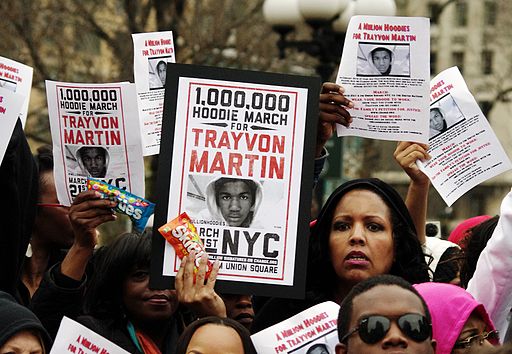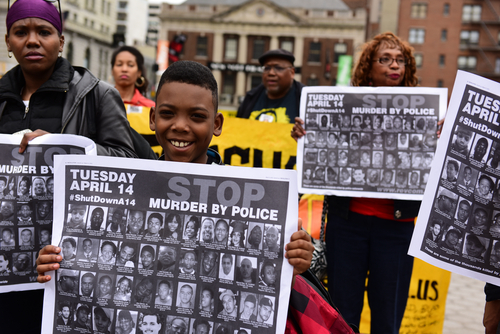
The Miller Center hosted a First Year event, “A new dialogue on race in America.”
Despite the election of our nation’s first black president—and in some ways, perhaps because of that fact—America, in the realm of race, remains embroiled in crisis, controversy, and catastrophe. That need not be the case, especially if we as a nation, and our new president individually, are willing to learn hard lessons from the Obama era and move forward with renewed determination to contend with our tattered racial legacy.
Over his two terms in office, President Barack Obama often was loath to lift his voice on race lest he be relegated to a “black box,” although his reluctance kept the nation from his wisdom and starved black folk of the most visible interpreter of their story and plight, an interpreter who also carried the greatest political clout in the nation’s history. His radio silence often sent the wrong signal that race, and black concerns, did not count as much as other national priorities.

After Harvard professor Henry Louis Gates, Jr. was arrested for trying to get into his own house, President Obama made a statement that was harshly criticized. The event made Obama hesitant to speak about race.
Questions of race—explicit and implicit—suffused the Obama presidency, for obvious reasons. Early in his tenure, the first black president was confronted with a test of how he would engage on what became the signature racial issue of his presidency—police treatment of African Americans. After Cambridge, Mass., police arrested black Harvard professor Henry Louis Gates Jr. for disorderly conduct in 2009, Obama said the officers “acted stupidly.”
First Year Video: Presidential Problems: Race And The Crisis of Justice
Gates had returned home from a trip to China to discover that his door was jammed, and as his driver helped him gain entry to his house, a passerby called the police, thinking it might be a break-in. The ensuing conflict between Gates and the police officer who responded to the call led to Gates’ arrest and a national debate about race and law enforcement.
Obama’s comment—as tepid as it would come to appear in contrast to the police misconduct controversies that would ensue later in his administration—was harshly criticized. The Gates confrontation made Obama deeply hesitant to speak on race and led him to three fateful conclusions:
A single event smoked Obama out of his presidential cubbyhole of racial nonengagement and thrust him into his bully pulpit to, in part, define, and then defend, black people—really to represent them, an extraordinary feat in itself.

After teenager Trayvon Martin was shot and killed and his killer was found not guilty, protests broke out over the injustice of the verdict.
It was the epic grief that gripped black America with the 2013 not-guilty verdict in Sanford, Florida, in the trial of self-styled neighborhood watchman George Zimmerman for the fatal shooting of black teen Trayvon Martin. That verdict, and the persistent injustice it highlighted, contrasted sharply with the broadly accepted narrative equating Obama’s ascent with the end of race (or racial problems/tensions) in America.
Obama spoke about Trayvon Martin to explain to white Americans why so many black folk were enraged over the verdict. Many white conservatives viewed Obama’s “one-sided” explanation of black suffering—a radical departure from the tough blows he had thrown black people’s way in most of his public pronouncements on blackness—as a surly betrayal of a “racial agreement” accepted by the president. Some whites believed that agreement was as follows: Do not speak much on race, and when you do, go after your own kind; offer the blandest platitudes possible about the progress made and the racial work that remains to be done.
The rash of racial crises during his presidency—from the Henry Louis Gates affair to the murders in June 2015 by a white supremacist of nine black people in a Charleston, South Carolina, church—led to calls for presidential leadership from the office’s famous bully pulpit, and yet Obama was often slow to command the rostrum to address race. “I’ve found in this position that it’s not always true that an incident automatically triggers a useful dialogue,” he told me, in an interview. “What you have to do is be able to create a place where people are willing to look at things in new ways and the media is willing to look at things in new ways. As president that means I’ve got to pick and choose my spots effectively.”
Obama’s record of effectively picking and choosing his spots was hit-or-miss; he often sabotaged his own standards with rhetoric that was far from organic, or surprising, perhaps because it grew from controversies that compelled him to react. It is understandable that Obama preferred being seen as the black president rather than the black president. But his refusal to address race except when he had no choice—a kind of racial procrastination—left him little control of the conversation. When he was boxed into a racial corner, often as a result of black social unrest sparked by claims of police brutality, Obama was mostly uninspiring: He warned (black) citizens to obey the law and affirmed the status quo.
Yet Obama energetically peppered his words to blacks with talk of responsibility in one public scolding after another. When Obama upbraided black folk while barely mentioning the flaws of white America, he left the impression that race is the concern solely of black people, and that blackness is full of pathology. Obama’s reprimands of black folk also undercut their moral standing, especially when his eager embrace of other minorities like gays and lesbians validated their push for justice. Obama was fond of saying that he was the president not of black America but of the entire nation. This reflected his faith in universal rather than targeted remedies for black suffering: blacks will thrive when America flourishes.
Obama’s views on race featured three characteristics, in various combinations: strategic inadvertence, in which racial benefit is not the expressed intent but the consequence of policies geared to uplift all Americans, in the belief that they will also help blacks; the heroic explicit, whereby he carelessly attacked black moral failure and poor cultural habits; and the noble implicit, in which he avoided linking whites to social distress or pathology—or moral or political responsibility for black suffering—and spoke in the broadest terms possible, in grammar both tentative and tortured, about the problems we all confront. It was an effort that, as we’ve seen with his famous race speech of 2008, drew false equivalencies between black and white experiences and mistook racial effects for their causes.

African Americans and other minorities have very little confidence that improving race relations is a priority for President Donald Trump.
President Obama’s successor, Donald J. Trump, generated very little confidence among African Americans and other minorities that improving relations between racial groups or the economic conditions of minorities was a priority for him. Nonetheless, if President Trump is sincere in his stated promise to be the president of “all of the people,” he must quickly and directly address the racial crises we confront and acknowledge them as the product of a malevolent history of racism that has tarnished our national will and our robust experiment in democracy.
For instance, after the Charleston church murders in 2015, former Secretary of State Hillary Clinton, in a speech before a mayor’s conference in San Francisco, directly addressed the swirling racial currents that flooded Charleston and the nation in the ugly sweep of violent animus—what Clinton later called “racist terror.” Clinton said in her speech that, tragically, despite our devotion to human rights and diversity, “bodies are once again being carried out of a black church,” and that, once again, “racist rhetoric has metastasized into racist violence.” Clinton argued that “it is tempting to dismiss a tragedy like this as an isolated incident, to believe that in today’s America, bigotry is largely behind us, that institutionalized racism no longer exists. But despite our best efforts and our highest hopes, America’s long struggle with race is far from finished.” She acknowledged that race is a difficult issue to talk about and that “so many of us hoped by electing our first black president, we had turned the page on this chapter in our history,” and that “there are truths we don’t like to say out loud or discuss with our children,” but that “we have to” because it is “the only way we can possibly move forward together.”
Clinton laid out the facts: Blacks are nearly three times more likely than whites to be denied a mortgage; the median income of black families is $11,000, while for whites it is $134,000; nearly half of black families have lived in poor neighborhoods for two generations, compared to just seven percent for whites; black men are more likely to be stopped and searched by police, charged with crimes, and sentenced to longer prison terms than white men—10 percent longer than white men for federal crimes; black students suffer from the vast resegregation of American schools; and black children are 500 percent more likely to die from asthma than white children. Clinton’s remarkable oration was steeped in black culture and charged with sophisticated analysis, and was a remarkably honest reckoning by a major American politician with both intimate and institutional racism—racism of the heart, and racism in the systems of society.
Our new president must clearly and consistently use his bully pulpit to offer such analyses and encourage the nation to engage our brutal racist legacy and together find a way forward.
Yet during the 2016 presidential campaign, Trump appeared insensitive to such considerations. He criticized a judge overseeing a lawsuit against Trump University for being biased because of his Mexican heritage. He, and his surrogates, usually lauded the cops amidst a rash of police brutality against unarmed black citizens. And despite finally admitting that President Obama was born in the U.S., the brashest of all Birthers, who contend that Obama is not an American citizen, confessed he only said it so he could “get on with the [presidential] campaign.”
Now Trump must fundamentally and immediately reconsider his approach to the current dialogue on race. Otherwise, his presidency will be marred by the most blatant racial vitriol to be witnessed and legitimated in a generation.

President Trump must craft public policy that addresses the challenges that are specific to the black community.
The new president must reject the adherence to strategic inadvertence and craft public policy that grapples with the specific features of black suffering. Obama believed that mainstream American ideas of equal opportunity are the catalyst, along with race-neutral goals, for improving the plight of minorities. His belief that universal programs provide a better outcome for minorities rested in part on political expediency: Whites will embrace these programs only if they offer everyone the potential to succeed. But the time has come to reject such an outlook and adopt a race-specific approach to black suffering. Some of the most prominent advocates of Obama’s approach have seen the light.
Sociologist William Julius Wilson wrote the 1990 article “Race-Neutral Policies and the Democratic Coalition,” arguing that Democrats, to expand the party’s base, should not emphasize race-specific policies like affirmative action, but should instead embrace race-neutral policies that overwhelmingly serve poor minority communities. Wilson has more recently changed his mind:
In my previous writings I called for . . . policies that would directly benefit all groups, not just people of color. My thinking was that, given American views about poverty and race, a color-blind agenda would be the most realistic way to generate the broad political support necessary to enact the required legislation. I no longer hold to this view.
So now my position has changed: in framing public policy we should not shy away from an explicit discussion of the specific issues of race and poverty; on the contrary, we should highlight them in our attempt to convince the nation that these problems should be seriously confronted and that there is an urgent need to address them. The issues of race and poverty should be framed in such a way that not only is a sense of fairness and justice to combat inequality generated, but also people are made aware that our country would be better off if these problems were seriously addressed and eradicated.
The new president would be wise to follow suit. One size does not fit all; one solution cannot possibly apply to all cases. If one visits the local hospital, some folk are downing aspirin for headaches, some are injecting insulin to stave off diabetic shock, while others are taking chemotherapy for cancer. Policies, like medicines, are most effective when they are targeted to the social ill at hand.
Finally, as unlikely as this will sound to so many Americans, President Trump must resist the temptation of the heroic explicit, or heedlessly and incautiously attacking perceived black moral deficiencies and harmful cultural habits, and forgo whatever short-term benefit may derive from embracing the noble implicit, where he fails to speak honestly about, and grapple with, racial transgressions in the white mainstream. Our new president must offer meaningful rhetoric that acknowledges and challenges white privilege, while also rejecting the notion of white innocence and ignorance about the vast reaches of racial injustice in our society—especially police brutality and the relentless death of unarmed black and brown people at the hands of white police.
The most effective way to accomplish this would be for the new white president to explicitly address the Black Lives Matter movement and some of the most salient underlying causes for its existence: flawed racial practices in law enforcement; the continuing racial inequality that mocks both true democracy and racial justice; the failure to wrestle with the interlocking forces of racial, gender, class and sexual oppression; and the persistent racial animus that flares with alarming violence like it did against Trayvon Martin and in the church in Charleston. An executive order in support of the recommendations of the President’s Commission on 21st Century Police Practices, submitted in 2015—coupled with a national address in the first months of his presidency underscoring the need for vigilance in defending the rights of black and brown American citizens in the face of dispiriting assaults and deaths—could powerfully move the nation forward.

The Black Lives Matter movement arose over flawed racial practices in law enforcement and the continuing racial inequality that mocks both true democracy and racial justice.
Whether Hillary Clinton or Donald Trump had won the 2016 election, the new president was already destined to face grave and difficult racial problems. But if President Trump is willing to directly confront them through enlightened public policy, and is willing to offer fresh thinking about how the social forces that blight the American scene are interrelated and vividly intersect, we have the best chance of making progress on race, which remains the most damning and enduring problem we face as a nation.